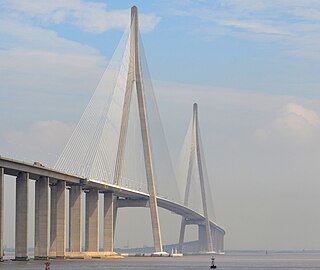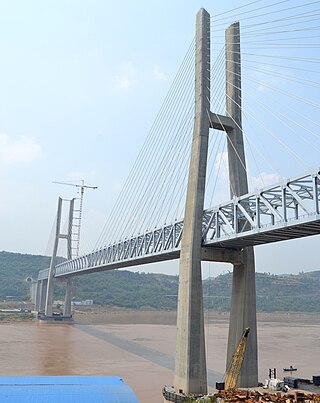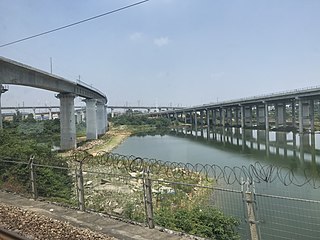
The Sutong Yangtze Bridge is a cable-stayed bridge that spans the Yangtze in China between Nantong and Changshu, a satellite city of Suzhou, in Jiangsu province.

The Nanjing–Qidong railway, commonly referred to in short as the Ningqi railway, is a higher-speed rail line in Jiangsu Province, China. Its common name is derived from Ning, the one-character abbreviation for Nanjing and Qi, which refers to Qidong, a county-level city of Nantong.

The bridges and tunnels across the Yangtze River carry rail and road traffic across China's longest and largest river and form a vital part of the country's transportation infrastructure. The river bisects China proper from west to east, and every major north–south bound highway and railway must cross the Yangtze. Large urban centers along the river such as Chongqing, Wuhan, and Nanjing also have urban mass transit rail lines crossing the Yangtze.

Double-stack rail transport is a form of intermodal freight transport in which railroad cars carry two layers of intermodal containers. Invented in the United States in 1984, it is now being used for nearly seventy percent of United States intermodal shipments. Using double stack technology, a freight train of a given length can carry roughly twice as many containers, sharply reducing transport costs per container. On United States railroads special well cars are used for double-stack shipment to reduce the needed vertical clearance and to lower the center of gravity of a loaded car. In addition, the well car design reduces damage in transit and provides greater cargo security by cradling the lower containers so their doors cannot be opened. A succession of larger container sizes have been introduced to further increase shipping productivity in the United States.

The Hanjiatuo Yangtze River Bridge is a cable-stayed railway bridge over the Yangtze River in the Fuling District of Chongqing, China. The bridge carries the Chongqing-Lichuan Railway and was completed in 2012.

Shanghai–Suzhou–Nantong railway, abbreviated as Husutong railway is a higher-speed railway in China's Yangtze River Delta area, connecting Shanghai, the region's main city located south of the Yangtze, with Nantong in Jiangsu province, north of the river.

Lanzhou Metro or Lanzhou Rail Transit is a rapid transit system in Lanzhou, Gansu, China.
The Shanghai–Chongqing–Chengdu high-speed railway is a high-speed rail line under construction in China. The Chinese name of the railway line, Huyurong, is a combination of the abbreviations for Shanghai, Chongqing, and Chengdu. It will run in an east-west direction largely parallel to the Yangtze River, connecting the cities of Shanghai, Nanjing, Hefei, Wuhan, Chongqing and Chengdu.

Yinchuan–Xi'an high-speed railway, is a dual-track, electrified, high-speed rail line in Northwest China between Yinchuan and Xi'an. The line is the first railway to connect Qingyang to the Chinese railway network, and also the first railway to connect Ningxia and Yinchuan to the high-speed railway network.

The Haoji Railway, fully known as Kholbolji/Haolebaoji to Ji'an railway, formerly known as Menghua Railway, is a 1,813.5 km (1,127 mi) freight-dedicated railway in China. It runs from Haolebaoji South railway station in Uxin Banner, Ordos City, Inner Mongolia to Ji'an railway station in Ji'an City, Jiangxi.
The Hangzhou–Taizhou high-speed railway is a high-speed railway in China. It was opened on 8 January 2022.

The Hefei–Anqing–Jiujiang high-speed railway is a 340-kilometre (211 mi) long high-speed rail line in China, with a maximum speed of 350 km/h (220 mph). It forms part of the Beijing–Hong Kong (Taipei) corridor. The line takes a similar route to the existing Hefei–Jiujiang railway.
The Wufengshan Yangtze River Bridge is a two-decked suspension bridge carrying the Lianyungang–Zhenjiang high-speed railway and the Jiangyi Expressway over the Yangtze. With a total length of 6,409 m (21,027 ft) and a main span of 1,092 m (3,583 ft), it is the world's longest span high-speed railway bridge, tied with the Hutong Yangtze River Bridge.











